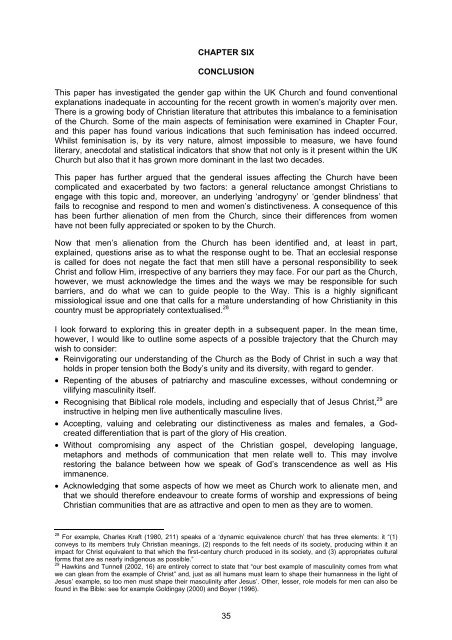Disbanded Brothers – Has a ‘Feminised’ Church Alienated Men in the UK?
Disbanded Brothers - Has a 'Feminised' Church ... - Theduckers.org
Disbanded Brothers - Has a 'Feminised' Church ... - Theduckers.org
- No tags were found...
You also want an ePaper? Increase the reach of your titles
YUMPU automatically turns print PDFs into web optimized ePapers that Google loves.
CHAPTER SIX<br />
CONCLUSION<br />
This paper has <strong>in</strong>vestigated <strong>the</strong> gender gap with<strong>in</strong> <strong>the</strong> <strong>UK</strong> <strong>Church</strong> and found conventional<br />
explanations <strong>in</strong>adequate <strong>in</strong> account<strong>in</strong>g for <strong>the</strong> recent growth <strong>in</strong> women’s majority over men.<br />
There is a grow<strong>in</strong>g body of Christian literature that attributes this imbalance to a fem<strong>in</strong>isation<br />
of <strong>the</strong> <strong>Church</strong>. Some of <strong>the</strong> ma<strong>in</strong> aspects of fem<strong>in</strong>isation were exam<strong>in</strong>ed <strong>in</strong> Chapter Four,<br />
and this paper has found various <strong>in</strong>dications that such fem<strong>in</strong>isation has <strong>in</strong>deed occurred.<br />
Whilst fem<strong>in</strong>isation is, by its very nature, almost impossible to measure, we have found<br />
literary, anecdotal and statistical <strong>in</strong>dicators that show that not only is it present with<strong>in</strong> <strong>the</strong> <strong>UK</strong><br />
<strong>Church</strong> but also that it has grown more dom<strong>in</strong>ant <strong>in</strong> <strong>the</strong> last two decades.<br />
This paper has fur<strong>the</strong>r argued that <strong>the</strong> genderal issues affect<strong>in</strong>g <strong>the</strong> <strong>Church</strong> have been<br />
complicated and exacerbated by two factors: a general reluctance amongst Christians to<br />
engage with this topic and, moreover, an underly<strong>in</strong>g ‘androgyny’ or ‘gender bl<strong>in</strong>dness’ that<br />
fails to recognise and respond to men and women’s dist<strong>in</strong>ctiveness. A consequence of this<br />
has been fur<strong>the</strong>r alienation of men from <strong>the</strong> <strong>Church</strong>, s<strong>in</strong>ce <strong>the</strong>ir differences from women<br />
have not been fully appreciated or spoken to by <strong>the</strong> <strong>Church</strong>.<br />
Now that men’s alienation from <strong>the</strong> <strong>Church</strong> has been identified and, at least <strong>in</strong> part,<br />
expla<strong>in</strong>ed, questions arise as to what <strong>the</strong> response ought to be. That an ecclesial response<br />
is called for does not negate <strong>the</strong> fact that men still have a personal responsibility to seek<br />
Christ and follow Him, irrespective of any barriers <strong>the</strong>y may face. For our part as <strong>the</strong> <strong>Church</strong>,<br />
however, we must acknowledge <strong>the</strong> times and <strong>the</strong> ways we may be responsible for such<br />
barriers, and do what we can to guide people to <strong>the</strong> Way. This is a highly significant<br />
missiological issue and one that calls for a mature understand<strong>in</strong>g of how Christianity <strong>in</strong> this<br />
country must be appropriately contextualised. 28<br />
I look forward to explor<strong>in</strong>g this <strong>in</strong> greater depth <strong>in</strong> a subsequent paper. In <strong>the</strong> mean time,<br />
however, I would like to outl<strong>in</strong>e some aspects of a possible trajectory that <strong>the</strong> <strong>Church</strong> may<br />
wish to consider:<br />
• Re<strong>in</strong>vigorat<strong>in</strong>g our understand<strong>in</strong>g of <strong>the</strong> <strong>Church</strong> as <strong>the</strong> Body of Christ <strong>in</strong> such a way that<br />
holds <strong>in</strong> proper tension both <strong>the</strong> Body’s unity and its diversity, with regard to gender.<br />
• Repent<strong>in</strong>g of <strong>the</strong> abuses of patriarchy and mascul<strong>in</strong>e excesses, without condemn<strong>in</strong>g or<br />
vilify<strong>in</strong>g mascul<strong>in</strong>ity itself.<br />
• Recognis<strong>in</strong>g that Biblical role models, <strong>in</strong>clud<strong>in</strong>g and especially that of Jesus Christ, 29 are<br />
<strong>in</strong>structive <strong>in</strong> help<strong>in</strong>g men live au<strong>the</strong>ntically mascul<strong>in</strong>e lives.<br />
• Accept<strong>in</strong>g, valu<strong>in</strong>g and celebrat<strong>in</strong>g our dist<strong>in</strong>ctiveness as males and females, a Godcreated<br />
differentiation that is part of <strong>the</strong> glory of His creation.<br />
• Without compromis<strong>in</strong>g any aspect of <strong>the</strong> Christian gospel, develop<strong>in</strong>g language,<br />
metaphors and methods of communication that men relate well to. This may <strong>in</strong>volve<br />
restor<strong>in</strong>g <strong>the</strong> balance between how we speak of God’s transcendence as well as His<br />
immanence.<br />
• Acknowledg<strong>in</strong>g that some aspects of how we meet as <strong>Church</strong> work to alienate men, and<br />
that we should <strong>the</strong>refore endeavour to create forms of worship and expressions of be<strong>in</strong>g<br />
Christian communities that are as attractive and open to men as <strong>the</strong>y are to women.<br />
28 For example, Charles Kraft (1980, 211) speaks of a ‘dynamic equivalence church’ that has three elements: it “(1)<br />
conveys to its members truly Christian mean<strong>in</strong>gs, (2) responds to <strong>the</strong> felt needs of its society, produc<strong>in</strong>g with<strong>in</strong> it an<br />
impact for Christ equivalent to that which <strong>the</strong> first-century church produced <strong>in</strong> its society, and (3) appropriates cultural<br />
forms that are as nearly <strong>in</strong>digenous as possible.”<br />
29 Hawk<strong>in</strong>s and Tunnell (2002, 16) are entirely correct to state that “our best example of mascul<strong>in</strong>ity comes from what<br />
we can glean from <strong>the</strong> example of Christ” and, just as all humans must learn to shape <strong>the</strong>ir humanness <strong>in</strong> <strong>the</strong> light of<br />
Jesus’ example, so too men must shape <strong>the</strong>ir mascul<strong>in</strong>ity after Jesus’. O<strong>the</strong>r, lesser, role models for men can also be<br />
found <strong>in</strong> <strong>the</strong> Bible: see for example Gold<strong>in</strong>gay (2000) and Boyer (1996).<br />
35






